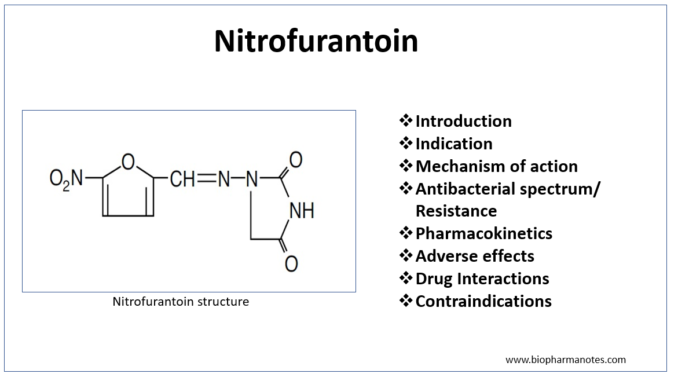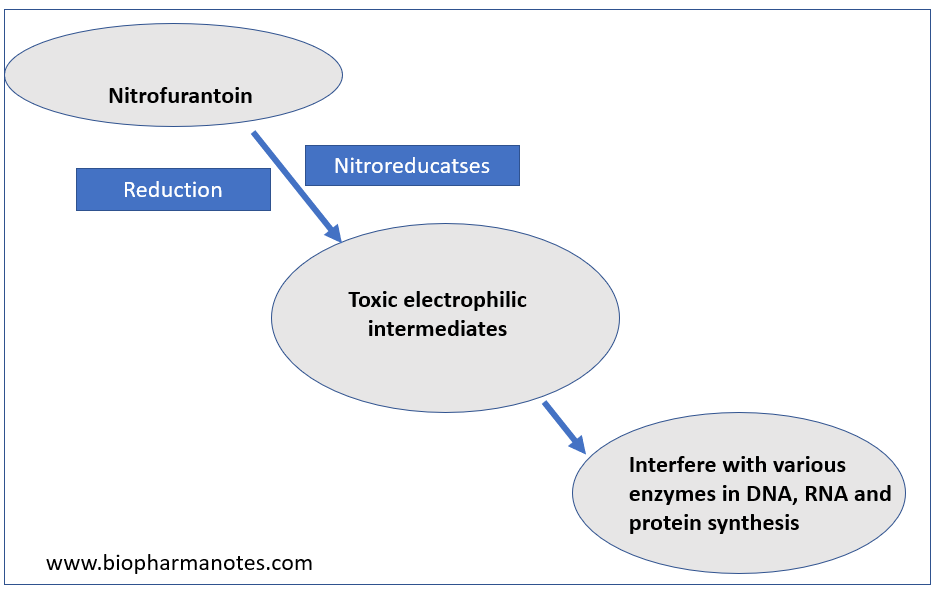
- Nitrofurantoin is synthetic nitrofuran used to prevent and treat UTI (Urinary Tract Infections). It was approved by FDA in 1953. It is included in World Health Organization’s List of Essential Medicines and it is also available as generic medicine.
- Structurally, it consists of hydantoin ring with a nitro substituted furanyl side chain.
Indications of Nitrofurantoin
- For prophylaxis of recurrent UTIs.
- To treat uncomplicated lower UTIS. Its use was infrequent due to availability of trimethoprim- sulfamethoxazole and newer beta-lactam antibiotics. However, some of the recent guidelines had repositioned it as first line therapy for uncomplicated lower UTI due to increasing resistance to fluoroquinolones and trimethoprim- sulfamethoxazole.
Mechanism of action of Nitrofurantoin

Figure- Mechanism of action of Nitrofurantoin
- It undergoes enzymatic reduction by bacterial nitro reductases to form electrophilic intermediates. These intermediates are highly reactive which bind to bacterial ribosomes and inhibit various enzymes involved in synthesis of bacterial DNA, RNA, cell wall proteins and other enzymes. This results in damage of bacterial DNA.
Antibacterial spectrum and resistance
- It has mainly bacteriostatic effect. At high concentration, it shows bactericidal effect. It is effective against various bacteria including E. Coli, Klebsiella species, Citrobacter species, Enterococcus faecalis, Coagulase negative staphylococci etc.
- Some bacteria like E. Coli, Klebsiella pneumoniae, Citrobacter and Enterobacteriaceae may show resistance to nitrofurantoin. The mechanism involved in resistance may be:
- Mutation in nitroreducatse (nfsA and nfsB) genes.
- ESBL (Extended Spectrum Beta- lactamase) production.
- Mutation of certain proteins.
Pharmacokinetics of Nitrofurantoin
- It is administered via oral route. Food increases its bioavailability. Hence, it is orally administered with food. It undergoes rapid and complete absorption from GI tract. Absorption takes place mainly from proximal part of small intestine.
- Its activity is pH dependent. It is more active at pH 8 than pH 5.5. So, the patients taking nitrofurantoin should pay proper attention to prevent alkalinization of urine.
- Its half-life is 0.3- 1 hour. Nitrofurantoin makes the urine color brownish. As the drug is eliminated rapidly, serum concentration is undetectable except in renal patients.
- Nitrofurantoin therapy should not be longer than two weeks (14 days).
Adverse Effects
- Common side effects are nausea, vomiting, anorexia and diarrhea. It can cause hemolytic anemia in patients with G6PD (glucose 6 phosphate deficiency).
- Nitrofurantoin may also cause hypersensitivity reactions, leukopenia, fever, hepatitis and cholestatic jaundice. It can cause acute pneumonitis which disappear with discontinuation of drug.
- Chronic use may cause interstitial pulmonary fibrosis. Its chronic use and use in patient with impaired renal function, severe polyneuropathies affecting both sensory and motor nerve may occur.
Drug Interactions
- Drugs like aceclofenac, acetyl salicylic acid, bleomycin may decrease excretion rate of nitrofurantoin. The risk of hyperkalemia may increase with concurrent administration of nitrofurantoin and drugs like acebutolol, aliskiren, clevidipine etc.
Contraindications
- It is not used in patients with significant renal impairment and azotemic patients.
- Contraindicated in pregnancy.
- It is not used in neonates younger than one month of age.
- Aged patients (more than 65 years) are more prone to developing pulmonary toxicity, hepatotoxicity and peripheral neuropathy due to nitrofurantoin administration. Hence, it is not recommended to be used in old patients.
- Contraindicated in men with UTI because in men such infections are mostly related to prostatitis.
- Contraindicated in patients with G6PD deficiency.
References
- https://www.ncbi.nlm.nih.gov/books/NBK470526/
- Huttner A et al. Nitrofurantoin revisited: a systematic review and meta-analysis of controlled trials. Journal of Antimicrobial Chemotherapy. 2015; 70(9): 2456–2464.
- https://go.drugbank.com/drugs/DB00698
- https://en.wikipedia.org/wiki/Nitrofurantoin
- Alam MS et al. Role of Nitrofurantoin in the Management of Urinary Tract Infection- A Systematic Review. J. Evolution Med. Dent. Sci. 2019; 8(50): 3805- 3812.
- Pharmacology and Pharmacotherapeutics. 24th edition.
- Goodman and Gillman Manual of Pharmacology and Therapeutics.